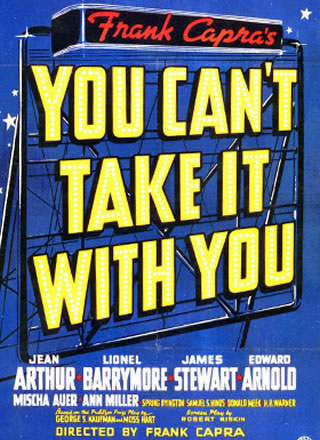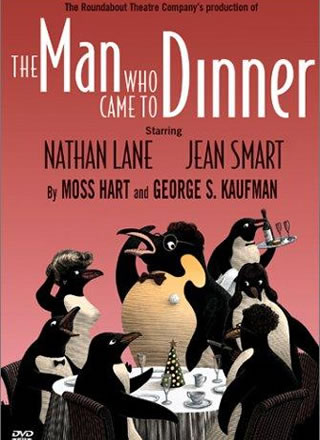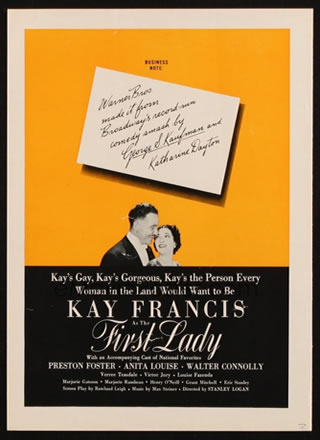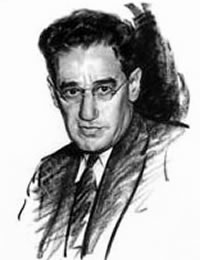You Can’t Take It With You
(1936)
By Moss Hart and George S. Kaufman

Cast size: 9 men, 7 women, 3 extras (small doubling possible), One set interior
Both Kaufman and Hart drew on various aspects of their own families to create the Vanderhof clan. It was put together easily for its Broadway debut and remains the most successful of their comedies, running 838 performances, a phenomenal number back in the 1930s. It went on to win the Pulitzer Prize, one of a handful of comedies ever to do so.
For professional performance rights, contact: Concord Theatricals
For amateur performance rights, contact: Dramatists
NOTE: We are pleased to offer licensees official changes that permit all and any of the characters to be played by a diverse cast of actors from all backgrounds.

Table of Contents
The Plot
The family of Martin Vanderhof lives “just around the corner from Columbia University—but don’t go looking for it.” Grandpa, as Martin is more commonly known, is the paterfamilias of a large and extended family: His daughter, Penny, who fancies herself a romance novelist; her husband, Paul, an amateur fireworks expert; their daughter, Alice, an attractive and loving girl who is still embarrassed by her family’s eccentricities—which include a xylophone player/leftist leaflet printer, an untalented ballerina, an African American couple on relief, and ballet master exiled from Soviet Russia. When Alice falls for her boss, Tony, a handsome scion of Wall Street, she fears that their two families—so unlike in manner, politics, and finances—will never come together.
During a disastrous dinner party, Alice’s worst fears are confirmed. Her prospective in-laws are humiliated in a party game, fireworks explode in the basement, and the house is raided by the FBI. Frustrated and upset, Alice intends to run away to the country, until Grandpa and Co.—playing the role of Cupid—manage not only to bring the happy couple together, but to set Tony’s father straight about the true priorities in life.
After all, why be obsessed by money? You can’t take it with you…
About the play
Both Kaufman and Hart drew on various aspects of their own families to create the Vanderhof clan. Kaufman’s father, Joseph, managed to raise his family just fine, but according to his “managed to get in on every business as it was finishing and made a total of $4. “Moss Hart” grew up in an atmosphere of unrelieved poverty” with “the grim smell of actual want always at the end of my nose,” as his writes in his memoir Act One. His beloved childhood idol was his eccentric Aunt Kate, who lived as if she were in the Belle Epoque and always went into Manhattan to the theater, no matter how strapped the family was. One hears the strains of Joseph Kaufman and Aunt Kate in the voices of Grandpa Vanderhof and Penny Sycamore.
By the time they wrote You Can’t Take It With You in 1936, Kaufman and Hart were at the height of their powers. The team managed to find some time in Los Angeles to collaborate on a play during the summer of 1936. They rejected a political farce and worked around the relatively plotless, character-driven story of a “slightly mad family,” as Kaufman put it in a letter to his wife.
“But it has a point,” he continued, “as you can see–that the way to live and be happy is just to go ahead and live, and not pay attention to the world.”
It was put together easily for its Broadway debut and remains the most successful of their comedies, running 838 performances, a phenomenal number back in the 1930s. It went on to win the Pulitzer Prize, one of a handful of comedies ever to do so. A film version, directed and heavily altered by Frank Capra, starred Lionel Barrymore and went on to win the Academy Award as Best Picture of 1938. The comedy remains, to this day, one of the two or three most popular plays among amateur, school, and community groups. Kaufman and Hart’s basic conception of this family–and the nature of families in general–strikes at something very deep in the American character.
Stage history
You Can’t Take It With You opened on December 14, 1936 at the Booth Theater and ran 838 performances. It was revived by Ellis Rabb’s APA-Phoenix company in 1966, with Donald Moffat and Rosemary Harris and ran over 250 performances in repertory. A subsequent revival, also staged by Rabb, opened at the Plymouth Theater with Jason Robards, Colleen Dewhurst, and Elizabeth Wilson and ran for 319 performances. This version was filmed for PBS. For television, Art Carney starred as Grandpa, along with Blythe Danner and Barry Bostwick as Alice and Tony for a 1979 primetime version of the play. A brief television series, updating the story and with Harry Morgan as Grandpa, ran briefly in the early 1980s.
Other Plays in the Catalogue
Be Yourself (1924). Book by George S. Kaufman and Marc Connelly. Music by Lewis E. Gensler and Milton Schwarzwald. Lyrics by George S. Kaufman and Marc Connelly
First Lady opened November 26, 1935 at the Music Box Theatre and ran 246 performances. It was filmed by Warner Bros in 1937. Aside from a 1996 revival at the Yale Repertory Theatre, it has not had a recent first-class production.
By Edna Ferber and George S. Kaufman. Cast size: 11 men, 22 women—not much doubling possible. Stage Door opened on October 22, 1936 at the Music Box Theatre and ran 169 performances.
Table of Contents
Contact Us Today
Interested in bringing George S. Kaufman’s timeless plays to your stage?
Please refer to the contact information for each specific play on the various collection pages for direct amateur and professional licensing information.
Plays are represented by Concord Theatricals, Broadway Dramatic Licensing, and Music Theatre International respectively
If you are interested in first-class performance or film/television rights:
In the US, George S. Kaufman’s plays are represented by:
CPK Artists, LLC
In the UK, George S. Kaufman’s plays are represented by:
Alan Brodie Representation
For more information about George S. Kaufman or this website, contact:
Laurence Maslon
Literary Trustee, George S. Kaufman Estate







